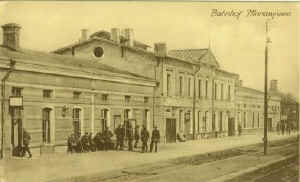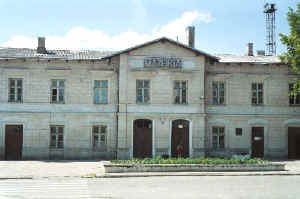

Brief History of Mazeikiai
The town of Mazeikiai was founded by the Duke of Zemaiciai Mazeika. Earliest records date from 1290. Historical sources from the beginning of the 14th century mention the Manor of Mazeikiai. The village of Mazeikiai was spoken of from the 16th century.
Until the 2nd half of the 19th century, Mazeikiai was a small village or hamlet, with a population of some tens of inhabitants, mostly farmers.
The settlement grew with the laying of the Libau (Liepaja) -Romny railway line in 1868 and the Mazeikiai – Riga line in 1872/4.
One of the railway stops was located at the crossing of three roads from Vieksniai, Leckava and Tirksliai, and it was named after a small farm whose master was Mazeika. This is how the town got its name.
As a major railroad junction, with tens of trains passing through its station daily, Mazeikiai developed rapidly into an urban settlement.
 Morawjewo Railway Station before 1918 |
 Mazeikiai Railway Station 2003 ( courtesy Benzi Kahana) |

General view of railway station in the 1920's
(courtesy Barbara Aharoni)
Map
from 1905 showing Mazeikiai at railway junction (red circle)
Mazeikiai grew rapidly after 1902, following the construction of the brick railway station (still existing), establishment of workshops for repair of locomotives and wagons, as well as schools for railway workers.
During the period of the Czarist Russian regime (1795 – 1915), Mazeikiai was first administratively included in the Vilna district, and from 1843 it was in the Shavli district.
On May 1, 1901, its name was changed to Morviova, after Governor General Marviov of Vilna, who oppressed the 1863 Lithuanian revolt.
In 1918, following to the end of World War I and establishment of the independent Lithuania, Mazeikiai regained its former name and from that time on it was a District Capital. This position was kept during the Soviet regime (1940-1941), the Nazi occupation (1941-1944) and again, after World War II, when Lithuania was included again as part of the Soviet Union.
After suffering considerable damages during the world wars, Mazeikiai was developed into a distinctive industrial town. The most remarkable industrial plant is the NAFTA oil refinery, established in 1980. Following to the collapse of the Soviet Union, and re-independence of Lithuania, most industrial factories are in the process of being privatized.
With population of 46,000, Mazeikiai is presently the 8th largest town in Lithuania.[1]
[1] References:
[1] Sefer Ha’Kehilot Lita (Book of Lithuanian Jewish Communities), Hebrew, p. 367
[2] Sefer Yahadut Lita (Lithuanian Jewry), Hebrew, pp. 323-324
[3] Mazeikiai Internet Sites:
a. Official Mazeikiai Municipality
b. Wikipedia
[4] Lithuanian Jewish Communities, by Nancy and Stuart Schoenberg, Garland Pub., NY & London 1991
This page is hosted at no cost to the public by JewishGen, Inc., a non-profit corporation. If you feel there is a benefit to you in accessing this site, your JewishGen-erosity is appreciated. Kindly link to : https://www.jewishgen.org/JewishGen-erosity/
| Compiled by Raymond Ravinsky Updated: August, 2019 Copyright © 2009 Raymond Ravinsky |
Link to : KehilaLinks Directory https://kehilalinks.jewishgen.org |
Link to : Jewish
Gen Home Page |